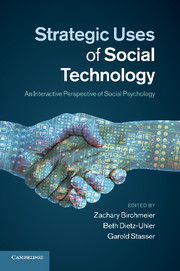Book contents
- Frontmatter
- Contents
- Figures
- Tables
- Notes on the contributors
- Acknowledgments
- 1 Introduction
- 2 A SIDE look at computer-mediated interaction
- 3 Trust, deception, and identity on the internet
- 4 An interactional approach to social influence in computer-mediated communication
- 5 Social interaction in cyberspace
- 6 Dynamics of leader emergence in online groups
- 7 Ostracism in cyberspace
- 8 Opinion-based groups
- 9 A juxtaposition of social influences
- 10 The virtual social world
- Index
- References
7 - Ostracism in cyberspace
Being ignored and excluded in electronic-based interactions
Published online by Cambridge University Press: 07 October 2011
- Frontmatter
- Contents
- Figures
- Tables
- Notes on the contributors
- Acknowledgments
- 1 Introduction
- 2 A SIDE look at computer-mediated interaction
- 3 Trust, deception, and identity on the internet
- 4 An interactional approach to social influence in computer-mediated communication
- 5 Social interaction in cyberspace
- 6 Dynamics of leader emergence in online groups
- 7 Ostracism in cyberspace
- 8 Opinion-based groups
- 9 A juxtaposition of social influences
- 10 The virtual social world
- Index
- References
Summary
This chapter presents a basic overview of ostracism, describing the reasons for its use, the situations in which it can occur, and the effects it has on its targets. Ostracism can happen in both face-to-face and electronic-based (e.g., internet, cell phones, and virtual reality) interpersonal interactions. The authors describe a variety of experimental research methods that have been used to study the effects of ostracism in both of these interpersonal contexts, comparing and contrasting the results of these different studies. Particular attention is paid to studies involving electronic-based interactions. Both immediate and long-term effects of ostracism on targets’ behaviors are discussed, focusing specifically on how people can be negatively impacted by being ostracized in an electronic-based interaction. The authors discuss how the nature of electronic-based interactions may affect people's reactions to ostracism in novel ways, providing greater understanding of the similarities and differences between face-to-face and electronic-based interactions. These findings are reexamined and explained in the context of virtual bravado – uninhibited behavior perhaps due to the anonymity provided by electronic-based communication. Finally, future directions of research are suggested for studying ostracism in electronic-based interactions, as well as people's general behavior in these types of interactions.
Introduction
There are several needs that are essential to our lives as human beings, and the desire to satisfy these needs influences our attitudes, behaviors, and interactions. Four of the most fundamental human social needs are the needs for belonging, self-esteem, control, and meaningful existence (Williams, 2001, 2009). Humans have a need to belong – they desire interpersonal relationships and meaningful interactions (Baumeister and Leary, 1995). Humans also have a desire to have reasonably high self-esteem (Leary et al., 1995; Tesser, 1988). Humans also have more action-focused needs; they desire some degree of control over their environment (Friedland et al., 1992), and knowledge that their existence matters to others (Greenberg et al., 1986; Solomon et al., 1991).
- Type
- Chapter
- Information
- Strategic Uses of Social TechnologyAn Interactive Perspective of Social Psychology, pp. 127 - 144Publisher: Cambridge University PressPrint publication year: 2011
References
- 8
- Cited by

